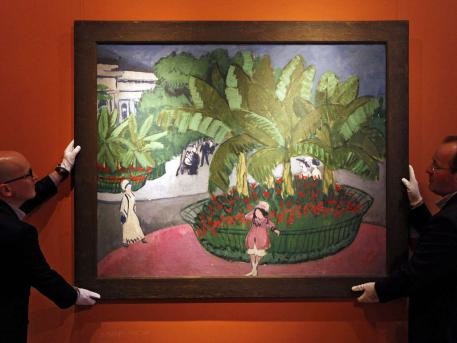In contrast to some of the more disturbing images on display in the ‘Mad Square’ exhibition at the NGV, there are hardly any at the current show “‘No one else has these colours’ – Kirchner’s Paintings” at the Kirchner Museum in Davos. The Davos exhibition focuses on the richness and intensity of colour in Kirchner’s oeuvre – his ‘Woman in a Hat’ shown at the NGV is particularly dark by comparison.
As the title suggests, the Swiss exhibition is all about colour. Bold as brass, Kirchner’s images jump off the canvas in full-on technicolor. The Kirchner Museum in the centre of this sprawling ski resort and conference metropolis is a beautiful piece of design in itself, created by Swiss architect Gigon Guyer and completed in 1992.
At 1560 metres, Davos is the highest city in Europe, and from the middle of the 19th century was a much sought after destination for sufferers of tuberculosis. Its reputation as a place for convalescence increased along with its status as ski resort and later home to the World Economic Forum.
Ernst Ludwig Kirchner (1880 – 1938) spent time in Davos sanatoriums after his nervous breakdown in 1915 while serving in the army. He moved permanently to Davos in 1918 and lived there until his death in 1938 by his own hand. War loomed again, and he had been classified as a ‘degenerate artist’ by the Nazi government. In 1937 over 600 of Kirchner’s paintings were confiscated from German museums and either destroyed or sold off.
Three of Kirchner’s paintings were included in the now infamous auction sale of ‘degenerate art’ at Galerie Fischer in Lucerne, Switzerland, on 30th June 1939. Amongst the 129 offerings were works by Van Gogh, Picasso, Modigliani, Matisse, Kokoschka, Gauguin, Dix, Braque Grosz, Beckmann and Chagall.
Many curators of the German museums, from which these paintings had been confiscated, were desperate to sell them at any price to dealers in other countries lest they should end up burned as so many were.* Many dealers however would not support such a sale as it was felt that monies raised would not go to the museums but to Nazi coffers – which was indeed the case.
Only £ 34,300 (500,000 Swiss francs) were raised from this auction, with a self-portrait by Van Gogh fetching the highest price – £ 12,000 or 175,000 Swiss francs.**
Kirchner’s three paintings all sold for a pittance: lot 60, ‘Pferde auf der Weide’, confiscated from the Kunstverein Chemnitz, sold for just £ 30, lot 61 ‘Damen im Café’ from the Moritzburg-Museum in Halle went for £ 50, and lot 62, ‘Bosketts’ from the Wallraff-Richartz-Museum, Cologne, also sold for £ 30.
 |
This lot, now known as ‘Das Boskett: Albertplatz in Dresden’, 1911, was re-sold by Kornfeld Auctioneers, Bern, Switzerland in 1991 for the staggering hammer price of US$ 1.96 million. Hold your breath though: it is going under the hammer once more on 8th February at Sotheby’s Impressionist and Modern Art Evening Sale in London – this time with an estimate of 5 to 7 million pounds. |
The Kirchner Museum was founded by the generous gifts of Rosemarie and Roman Ketterer and the Benvenuta family foundation. It now comprises over 1,500 of his paintings, sculptures, prints, textiles, 160 sketchbooks plus a substantial archive, which includes also works by Lyonel Feininger, Erich Heckel, Alexey von Jawlensky and Otto Mueller. The current show however is also drawn from private and public European collections and presents results of a research project of Kirchner’s paintings supported by the German government.
Davos is clearly proud of its adopted son, and the museum and its holdings are a fitting tribute to a founding father of German expressionism. To be able to view so many works that were produced in Davos gives them a compelling resonance and beauty.
References:
‘The Mad Square – Modernity in German Art 1910 – 1937’ is on until 4 March 2012 at the National Gallery of Victoria in Melbourne.
“ ‘No one else has these colours’ – Kirchner’s paintings” is on until 15th April 2012 at The Kirchner Museum in Davos, Switzerland.
* Lynn H. Nicholas, in ‘The Rape of Europa – The Fate of Europe’s Treasures in the Third Reich and the Second World War’, Vintage Books, 1995, writes on pages 24-25: “ … [Dealer Rolf] Hetsch sold works for practically nothing, simply to get them out of the country. A post-war study lists more than 20 pages of objects distributed from the Nationalgalerie’s collections alone. Even a little sample of the prices paid makes unbelievable reading:
M. Beckmann, Southern Coast, $ 20 to Buchholz
M Beckmann, Portrait, SFr 1 to Gurlitt
W. Gilles, 5 Watercolours, $ 0.20 each to Boehmer
W. Kandinsky, Ruhe, $ 100 to Moeller, [now Guggenheim Museum, New York]
E. Kirchner, Strassenszene, $ 160 to Buchholz [now MoMa, New York]”
**Original auction catalogue, Galerie Fischer, Lucerne, 30 June 1939, ‘Gemaelde und Plastiken Moderner Meister aus Deutschen Museen’
Article originally published in the Australian Art Sales Digest
